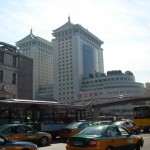Beijing or Peking
Beijing or Peking (from Chinese literally translated as “northern capital”) is the capital and one of the cities of central submission of the People’s Republic of China. Beijing is surrounded on three sides by the province of Hebei and borders Tianjin in the South-East.
Beijing is the third largest city in China by population after Chongqing and Shanghai. It is the biggest railway and highway hub and one of the main airway-hubs of the country. Beside that, Beijing is the political, educational and cultural center of the PRC, while the main economic centers are considered to be Shanghai and Hong Kong. At the same time recently Beijing has been assuming more and more a role of a locomotive of business activity and the main field for creation of innovational enterprises.
Beijing is one of the four ancient capitals of China. In 2008 in Beijing the Summer Olympic Games were held.
Beijing is located within the limits of a low land on the north end of the North-Chinese Plane. About 3/5 of the city’s territory, including suburbs, lies in a mountainous area, which surrounds the Old City from the West, North, and East. In the vicinity if Beijing several rivers flow across the plane including Bai He and Yongding which are the main source of the city’s water supply. Beijing is located inside a seismically dangerous zone. Spring and summer monsoon winds that blow from North-West and South-East affect the weather in Beijing. In early spring North-Western winds from the wilderness of Gobi cloud the city with yellow dust. In summer South-Eastern winds from the ocean cause strong rain showers, and because of that around ¾ of the annual amount of precipitation (610 mm) fall down during the summer season. In general the summer in Beijing is hot and humid, while the winter is cold and dry. However, from the middle of September till November the weather is clear, cool, and very nice.
In 2005 the population of Beijing defined as the number of people living in it for more than 6 months per year was estimated as 15.380 million people. Among them 11.870 million were officially registered as Beijing citizens, while others lived in Beijing by temporary permits. Besides, there are many labor migrants living and working in Beijing, mostly from rural areas, who are called mingong (literally “peasant workers”). They live in the city illegally, that is why they are also called heijen (literally “black people”). It is the most unprotected and discriminated part of society which becomes the source of cheap work force and crime. The population of the city proper makes close to 7.5 million people.
Among Beijing dwellers 95% are Han (that is, ethnical Chinese). The main ethnical minorities are Manchu, Hui (Dongxiang), Mongols, and others.
There is a large number of foreigners living in Beijing, mainly businessmen, representatives of foreign companies, and students. Most foreigners prefer to settle in densely populated northern, north-eastern, and eastern districts of the city. In the recent years there has been a big inflow of South Koreans, who are now making the largest foreign community in China. Most Chinese live in districts Wangjing and Wudaokou.
Cities within the area of Beijing existed since 1000 B. C. On the territory of today’s capital of China there was a city called Ji — the capital of the Yan kingdom, one of the states in the period of the Warring Kingdoms (473-221 B. C.).

